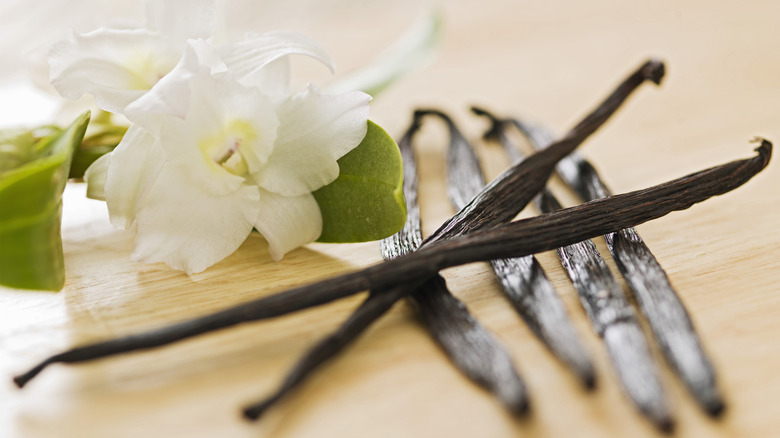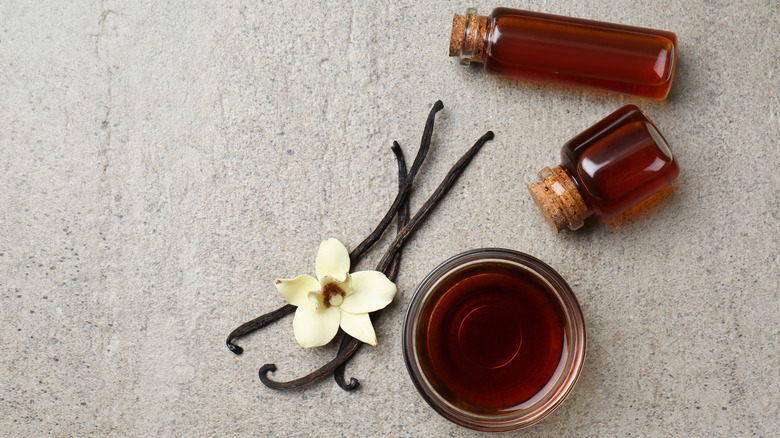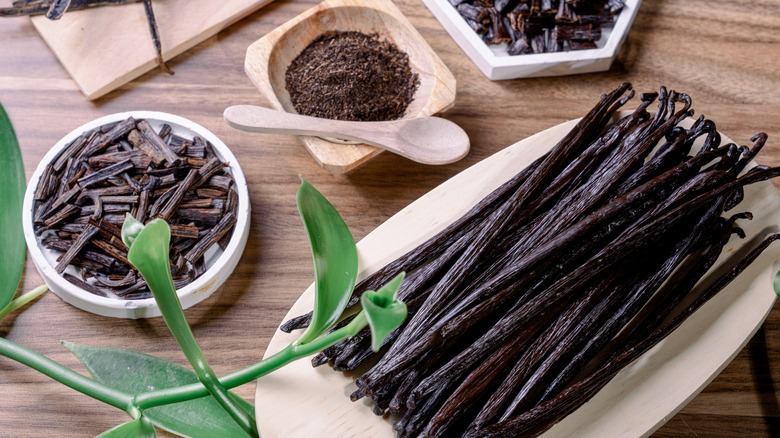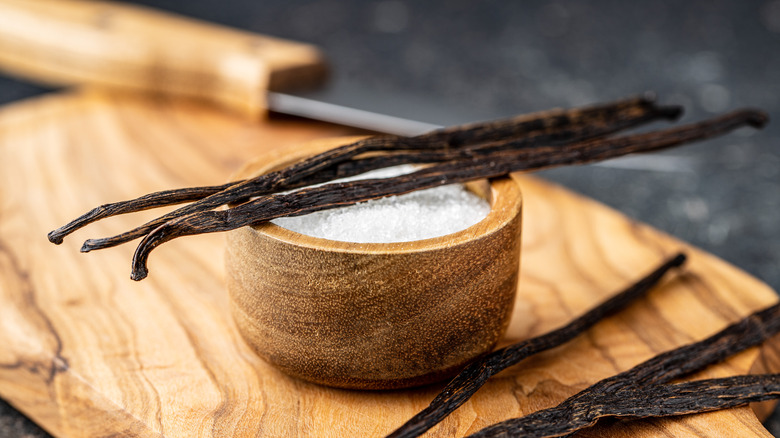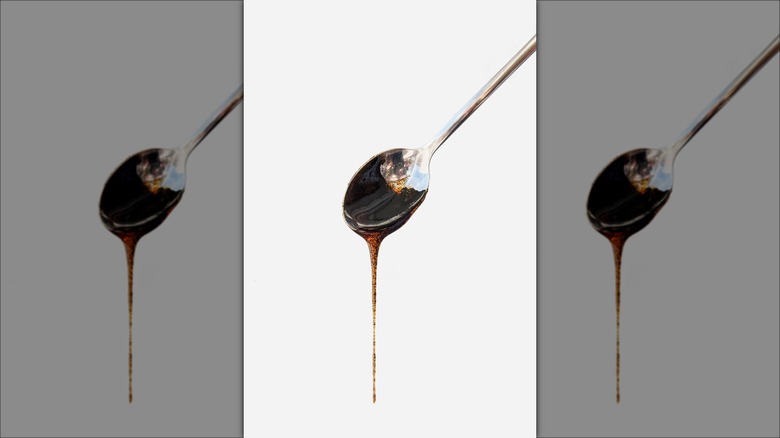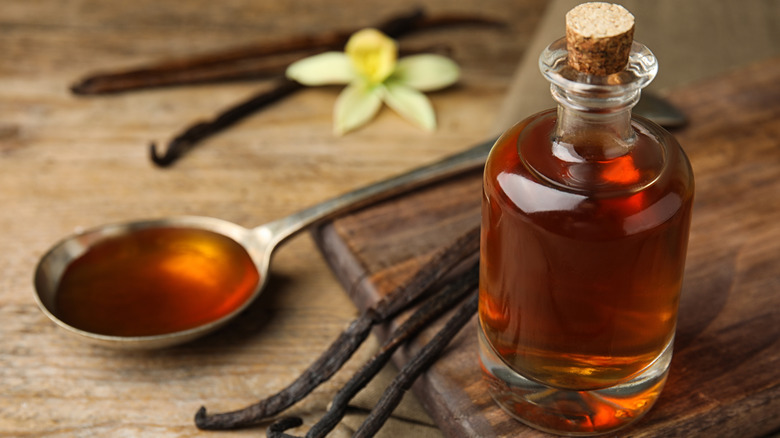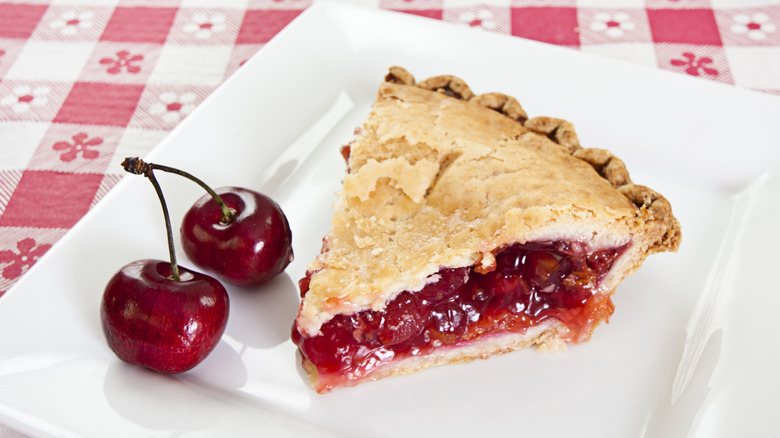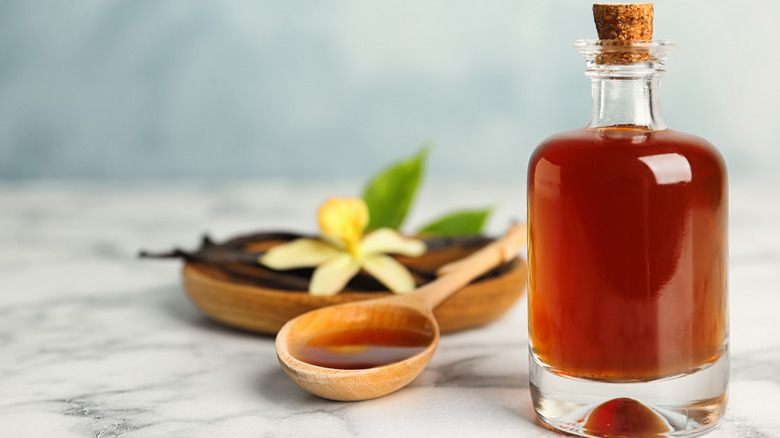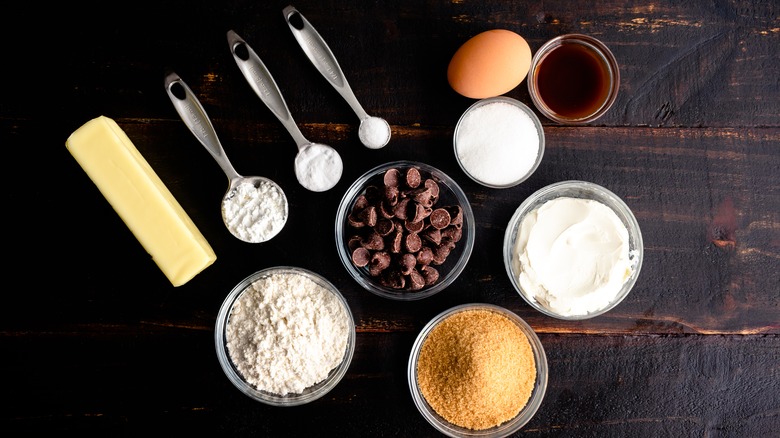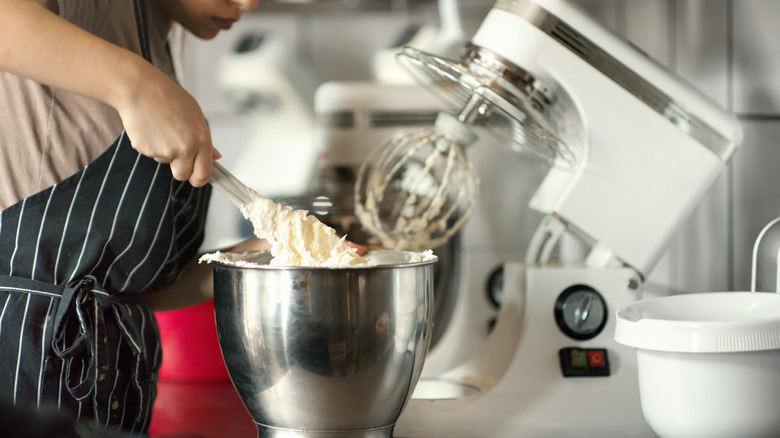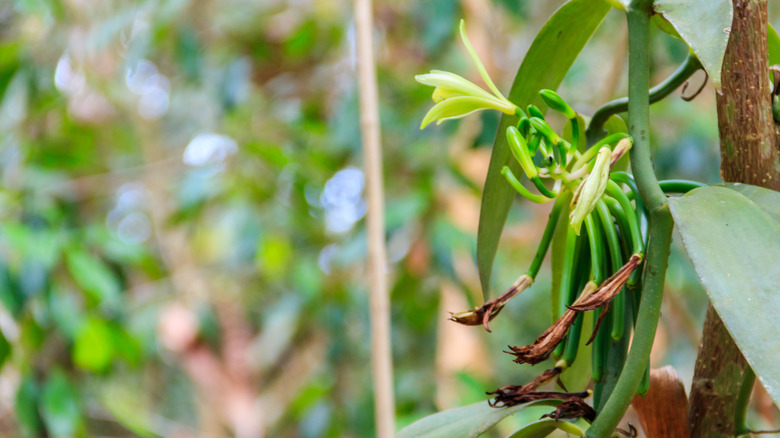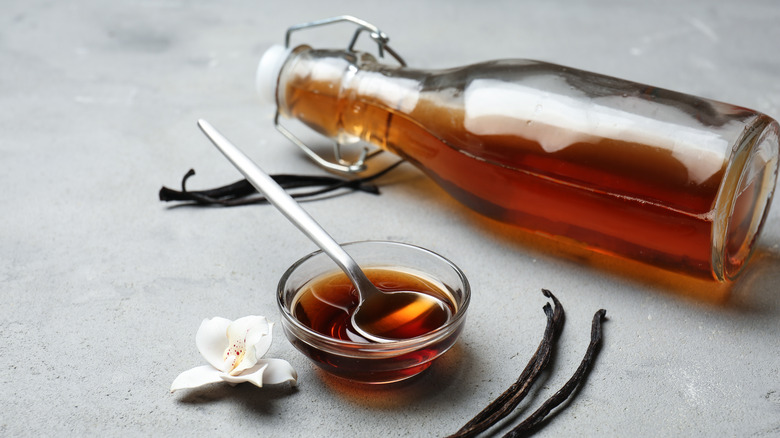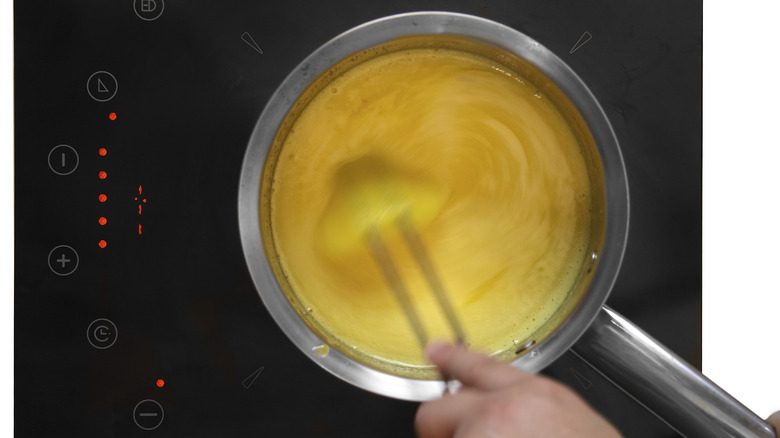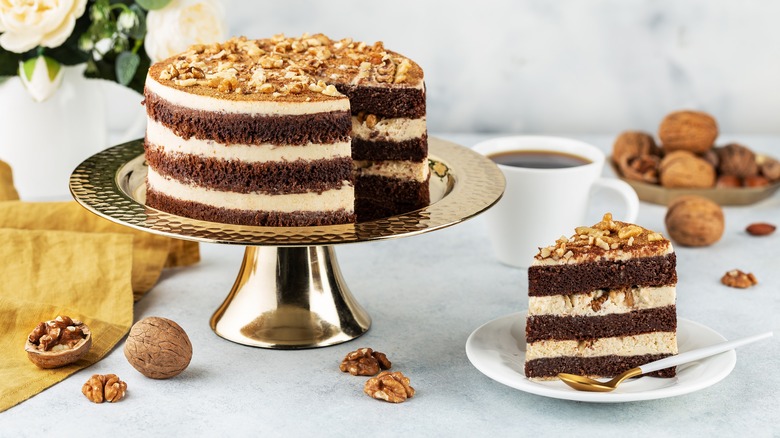Mistakes Everyone Makes When Baking With Vanilla
"Vanilla" is sometimes thrown around as an insult to mean bland or boring, with it having an underwhelming reputation. But this beautifully aromatic spice is far from dull. If you believe vanilla equals insipid and moderately tasteless, then you've probably been using it wrong. And, you're not alone — there are many common mistakes people make with vanilla. Like most things in baking, it requires precision and a bit of know-how to get to the bottom of.
We interviewed four baking experts to learn everything we needed to know about vanilla, including frequent missteps and how to avoid them. From using vanilla essence instead of extract to buying subpar vanilla extract to storing vanilla incorrectly, there are a number of ways to misuse this common ingredient. And, it's not just about doing things the right way for the sake of it. When you learn how to use vanilla correctly, your bakes will come out even more delicious.
Using imitation vanilla
One of the biggest mistakes people make when baking with vanilla is using imitation vanilla instead of the real thing. The difference between pure and imitation vanilla extract is that pure vanilla has a beautiful, nuanced flavor profile, and imitation vanilla just cannot compare. "While imitation vanilla is often cheaper, it lacks the depth of flavor provided by real vanilla, which comes from the natural compounds in vanilla beans," explains Jessica Randhawa, recipe creator at The Forked Spoon. "This can result in baked goods that are less flavorful and have a slightly artificial taste," she adds.
If you're new to baking or don't bake often, you might not realize the difference between real and artificial vanilla, or know how to find the right one for your recipe. "Typically, vanilla essence is an artificially made vanilla flavoring," says Martin Sorge of Martin Bakes, winner of "The Great American Baking Show" in 2023. On the other hand, "vanilla extract is typically made by infusing vanilla beans in alcohol, which is an excellent flavor carrier," he notes.
So, if you're faced with the decision between vanilla extract and vanilla essence at the grocery store, it's the extract you should be going for. Vanilla essence is imitation vanilla and won't give your baked goods the same depth of flavor. It's also worth noting that while artificial vanilla is usually labeled as vanilla essence, it may occasionally just be called vanilla. Options made from real vanilla are usually labeled pure vanilla extract.
Not considering vanilla pods
If you think the only option for adding vanilla beans to your recipe comes in a bottle, think again. While not everyone will want to go to the effort of using vanilla pods, they're certainly worth considering. But, first you might want to learn more about them and how to use them.
"Vanilla beans are the whole vanilla pod, and they offer the most robust and complex flavor," remarks Martin Sorge. "You typically split the pod in two and scrape the seeds from the pod and add them to your bake," he explains. "If you're making something like a custard, cake soak, or ice cream base, you can toss the scraped seeds and the empty pod into the milk, bring it almost to a simmer, then turn off the heat. Cover and let the beans infuse for at least 30 minutes or up to 24 hours for a ton of vanilla flavor (remove the pod after it has steeped)."
Vanilla beans offer the most truly vanilla-y flavor. It's like the difference between a fresh orange and orange extract. Yes, the orange extract is going to taste like orange, but it's not going to have all the nuances of taste that you'll get from a fresh orange. Admittedly, vanilla pods are expensive, though, and cooking with them is more time consuming than cooking with vanilla extract. So, it's something you'll probably want to save for times when you're making a special bake.
Throwing away the pods after using vanilla seeds
You've taken the plunge and used a fresh vanilla pod. You might think that once you've scraped the tiny seeds out from inside the bean, it's offered you everything it has and so you should throw the remainder away. But, there's actually more you can get from the pod, even once the seeds are gone.
So, what do you do with the leftover bean? "You can put the vanilla pod in some sugar to make vanilla sugar, or you can even use them toward making your own vanilla extract at home," says Maggie Turansky of No Frills Kitchen. Since vanilla beans are pricey, this is a good way of getting the most bang for your buck. She adds, "Even if you've been steeping an entire vanilla bean in, say, a custard, make sure to fish the pod out, give it a rinse, and then use it for the above examples. Vanilla beans are too expensive — and too flavourful — to let them go to waste."
If you decide to make vanilla sugar from your spent vanilla pods, the longer you leave it to absorb the flavor from your beans, the better. It won't be quite as potent as vanilla sugar made with the seeds, as well as the pod, but it's still good. Martin Sorge notes that vanilla sugar is "great for adding rich vanilla flavor, especially when you don't want to add any liquid" to your recipe.
Not exploring vanilla bean paste
Many people think that their main options for adding vanilla to recipes is either using liquids like vanilla extract and vanilla essence or using whole vanilla beans. However, there's another option worth exploring that can make baked goods even better: vanilla bean paste. So, what is it and how do you use it?
This paste is somewhere between a vanilla extract and vanilla beans, taste and quality-wise. It's made by combining vanilla bean powder and concentrated vanilla extract. Rather than being a liquid, like vanilla extract, it's a thin but slightly viscous paste. It has a sweet flavor without the alcohol kick of vanilla extract and it mixes easily into all kinds of batters and doughs. Generally, you use it as a 1:1 replacement for vanilla extract — meaning, if a recipe calls for 1 teaspoon of vanilla extract, you use 1 teaspoon of vanilla bean paste. That said, the ratios may be different for some brands, so check the container before using.
You should be using vanilla bean paste in your cookies and beyond. It gives you the specs of fresh vanilla bean without having to go to the extra effort of scraping the seeds from the pod or infusing the pods in milk or sugar. Yes, it's on the more expensive side, but it still tends to work out cheaper than vanilla beans. It's a great choice for people who don't mind splashing out for a high-quality vanilla flavor in their baked goods.
Ignoring the option of homemade vanilla extract
If you bake with vanilla regularly, it's worth exploring homemade vanilla extract as an option. What's great about homemade vanilla extract is that you can choose your vanilla beans, use more or less according to your preferences, and leave it to cure for a year or more before using — meaning that you can make exceptionally flavorful extract. What's more, it can work out cheaper than decent-quality store-bought extract, especially in the long run.
Making homemade vanilla extract is a straightforward process that requires only two ingredients: vanilla beans and alcohol. To start, you need vanilla beans. Split them and scrape out the seeds before cutting the pods into ½ inch pieces. Place the vanilla seeds and beans in a clean glass jar and pour alcohol over them, covering the beans completely. Use around 8 ounces of alcohol per 4-6 vanilla pods.
Vodka is the most commonly used alcohol for vanilla extract due to its neutral flavor, but you can also use rum or bourbon for added depth of flavor. Seal the jar tightly and store it in a cool, dark place. For the first week or two, shake the jar daily. After this, you can shake it once or twice a week. Once the liquid has burned brown and fragrant, it's ready to use, but the longer you leave it, the better it will taste. Letting it steep for 6 to 12 months is ideal.
Assuming all baked goods need vanilla
Most baking recipes include vanilla extract, so we can understand why you might assume every sweet baked good needs some form of vanilla. However, if you use vanilla extract or vanilla beans every time you bake something sweet, you're making a mistake.
Sara Haas, a recipe developer at BāKIT Box, explains: "Not every dessert has a flavor profile that's complemented by vanilla. Cherry pie, for example, is actually better with a touch of almond vs. vanilla extract." Martin Sorge agrees that vanilla should be used on a case-by-case basis: "If you're making a classic lemon cake, you want that bright tangy citrus flavor, and it doesn't need to be dulled with vanilla," he notes.
So, yes, vanilla is delicious, but no, it doesn't need to be used in absolutely every recipe. If you're unsure whether to use vanilla, first think of the flavor profile and work out whether you think vanilla will be a help or a hindrance. Still unsure? Consult a number of recipes to see whether or not they use vanilla and follow suit.
Buying poor quality vanilla extract
Quality matters when buying vanilla extract. "Many bakers will assume that vanilla is just something supplementary to add to a recipe, rather than fully realizing the complexity and depth of flavor that good, pure vanilla extract can add," says Maggie Turansky. Even if you avoid the artificial stuff, there's still a big difference between the cheapest pure vanilla extract you can buy at the store and the more expensive ones.
The best quality vanilla extracts tend to have not only a punchier vanilla flavor, but one with more nuance to it. You can really taste the fruity and floral notes of the vanilla rather than getting a one-dimensional vanilla flavor. That said, whether or not it's worth splashing out on a high-quality extract might depend on the recipe. Sara Haas recommends that people making a vanilla-forward dessert should "splurge for the nicer pure vanilla extract." However, she adds that "If it's a tiny amount and vanilla isn't a huge focus, I would say save your money."
Adding too little vanilla or too much
Using either too much or too little vanilla in a recipe can mess things up. When you have too much vanilla in a recipe where you want other flavors to come through, it can ruin the balance. However, using too little vanilla is an issue, too. You might get very little vanilla flavor in your baked goods or you might not be able to taste it at all.
Does that mean that you should always use the exact amount listed in a recipe? Not necessarily! "Many bakers also tend to be conservative with the amount of vanilla they use, not realizing that a little extra can significantly enhance the flavor of sweets," says Jessica Randhawa. "Especially in recipes that are heavy on sugar and fats, like cakes and cookies, increasing the vanilla slightly can elevate the overall taste profile." But, more isn't always better. She adds that you should "taste as you go since too much vanilla can also overwhelm the other flavors."
Leaving vanilla out when a recipe calls for it
Maggie Turansky notes that some bakers choose to omit vanilla in their baked goods altogether, even when a recipe calls for it. This can be because they don't realize how much vanilla adds to a recipe. Vanilla is often seen as a subtle, basic flavor. And, it's this reputation that can cause people to think it's more of an added extra than an integral ingredient.
But, vanilla brings a lot to the party. Even in baked goods where it isn't the primary flavor, it brings depth. Without it, bakes can be fairly one-note. Especially when you're talking about things like chocolate chip cookies where vanilla flavors the cookie part of the cookie, even if chocolate from the chips is what steals the show.
We get how tempting it is to forgo vanilla when you start baking only to realize that you've run out of extract. Or when you're buying ingredients and see how pricey pure vanilla extract can be. But, it's worth that extra trip to the store or that few extra bucks. If you leave vanilla out, you'll only be disappointed by the lack of flavor in your baked goods.
Not understanding the different types of vanilla available
You might have noticed that there are different varieties of vanilla available. There are three main types you'll find in stores: Tahitian, Mexican, and Madagascan (also known as bourbon vanilla). Sometimes vanilla extract or vanilla beans are labeled with their variety and sometimes they aren't. But, just because they aren't always labeled, it doesn't mean variety is irrelevant.
"Overlooking the variety of vanilla can be a misstep for those aiming to achieve specific flavor notes in their baking," says Jessica Randhawa. "Different types of vanilla have unique flavors and strengths," she notes. "For instance, Mexican vanilla can have a spicy, woody touch, while Tahitian is known for its floral and fruity notes." Meanwhile, Madagascan vanilla tastes particularly sweet and creamy, but with some more complex woody and smoky notes.
Martin Sorge agrees that vanilla variety makes a difference in baked goods. He notes that certain varieties pair better with particular ingredients. "For me, the fruity, bright Tahitian beans pair well with things like coconut (almost making it taste more coconutty), cherries, apricots, mango, and many other fruits," he says. Whereas, he prefers Madagascan vanilla "with deeper flavors like chocolate and caramel." If you're really serious about baking, you might want to have a few different vanilla varieties in your pantry, so you can use the right one for the recipe at hand.
Storing vanilla incorrectly
Storing vanilla extract properly is crucial for maintaining its flavor and potency. Too much light and heat can cause the flavor compounds to break down, so it doesn't taste as strong or as complex. According to Sara Haas, the best way to store vanilla extract is "in a cool, dark place." Some vanilla extract comes in opaque bottles to minimize its contact with light, but it still helps to keep it somewhere dark, such as a kitchen cabinet.
You might think that because heat is bad for it, that keeping vanilla extract in the fridge or the freezer will help it last longer. But, since it contains alcohol, freezing or refrigeration actually won't keep it fresher for longer. And, in fact, chilling it can affect the complexity of its flavor, so it's best avoided. Contact with oxygen is another way that vanilla extract can degrade and lose flavor. Haas says that you should "keep it tightly sealed in its original container" to help keep it fresh for longer. However, if you need to decant it from its original container for some reason, make sure you store it in something airtight.
Adding vanilla too early
In some recipes, particularly those that require long cooking times or involve high heat, adding vanilla extract too early can lead to the loss of its delicate flavors. "Vanilla extract is alcohol-based, and exposing it to high temperatures can cause the flavor to evaporate, diminishing its impact on the dish," explains Jessica Randhawa. In baked goods, there really isn't a choice but to add the vanilla before baking. However, this isn't a problem; vanilla extract starts to evaporate between 280 and 300 degrees Fahrenheit, but the internal temperature of baked goods while they're cooking is around 210 degrees.
However, when you're making fillings, sauces, and syrups for your baked goods — such as crème pâtissière or a soaking syrup — this is when you might want to pay more attention to when you add the vanilla extract. "To preserve the richness of vanilla's flavor, it's best to add it at the end of cooking," Randhawa suggests. You can either add vanilla extract towards the end of the cooking time or just after it's been taken off the heat. Stirring in the vanilla extract while the mixture is still warm allows the flavors to blend without risking flavor loss due to prolonged heat exposure.
Not using other extracts alongside vanilla extract
Have you ever assumed that you can only use one type of extract per recipe? When you're using vanilla extract, do you think that you can't use another type of extract? If so, then you've been making a mistake. It's perfectly fine to use more than one type of extract in your baked goods — in fact, it can improve them.
There are all kinds of pairings that you can try in different bakes. For instance, you might choose a combination of vanilla extract and coffee extract in a coffee and walnut cake, vanilla extract and almond extract in cookies or a tart, and orange extract and vanilla extract in chocolate orange cookies or brownies. The great thing about vanilla is that it doesn't tend to fight against other flavors. It brings its own delicious notes, but they don't clash with most flavors, so it's a versatile choice. That's not to say that you always have to have vanilla extract in every bake, but you can absolutely experiment with flavor combinations using vanilla and other extracts.
